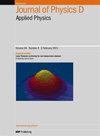Corrosion-resistant behavior and structural optimization of Ti/Cr, Ti/Cu, Cr/Cu , Ti/Cr/Cu multimetallic layer coatings in simulated seawater
IF 3.1
3区 物理与天体物理
Q2 PHYSICS, APPLIED
引用次数: 0
Abstract
This article is based on the sacrificial anode cathodic protection principle and the optimization method of multilayer structure. According to the standard electrode potential of metals, starting from the corrosion-resistant passive film formed by the metal itself, Ti/Cr, Ti/Cu, Cr/Cu, and Ti/Cr/Cu coatings were prepared on a 316L stainless steel substrate using magnetron sputtering technology. The corrosion performance of the coatings was studied to explore the interaction patterns between them.The results showed that in artificial seawater, the Cr/Cu, Ti/Cu, and Ti/Cr metal bilayer film coatings exhibited an increasing impedance arc radius and widening phase angle plateau in the electrochemical impedance spectroscopy. In the polarization curve, the self-corrosion current, the self-corrosion potential and polarization resistance are all better than the substrate. In the static immersion test, the weight loss rate of the metal multi-layer film gradually decreased, with all samples showing a lower weight loss rate in the second week compared to the first week, ranging from 27% to 52%. By further designing the microstructure of the coating to mitigate the contradiction between hardness and toughness, and reduce the generation of pores, the corrosion performance of the new Ti/Cr/Cu coating is significantly improved. The coating can repair surface defects of the material, fill in micro and nano gaps, and enhance the cathodic protection effect of sacrificial anodes.模拟海水中 Ti/Cr、Ti/Cu、Cr/Cu、Ti/Cr/Cu 多金属层涂层的耐腐蚀行为和结构优化
本文基于牺牲阳极阴极保护原理和多层结构优化方法。根据金属的标准电极电位,从金属本身形成的耐腐蚀被动膜出发,采用磁控溅射技术在 316L 不锈钢基体上制备了 Ti/Cr、Ti/Cu、Cr/Cu 和 Ti/Cr/Cu 涂层。结果表明,在人工海水中,Cr/Cu、Ti/Cu 和 Ti/Cr 金属双层膜涂层在电化学阻抗谱中表现出阻抗弧半径增大和相角台阶增宽的现象。在极化曲线中,自腐蚀电流、自腐蚀电位和极化电阻均优于基底。在静态浸泡试验中,金属多层膜的失重率逐渐降低,所有样品在第二周的失重率都比第一周低,从 27% 到 52% 不等。通过进一步设计涂层的微观结构,缓解硬度和韧性之间的矛盾,减少孔隙的产生,新型 Ti/Cr/Cu 涂层的腐蚀性能得到显著改善。该涂层可以修复材料的表面缺陷,填补微纳米间隙,增强牺牲阳极的阴极保护效果。
本文章由计算机程序翻译,如有差异,请以英文原文为准。
求助全文
约1分钟内获得全文
求助全文
来源期刊
CiteScore
6.80
自引率
8.80%
发文量
835
审稿时长
2.1 months
期刊介绍:
This journal is concerned with all aspects of applied physics research, from biophysics, magnetism, plasmas and semiconductors to the structure and properties of matter.

 求助内容:
求助内容: 应助结果提醒方式:
应助结果提醒方式:


